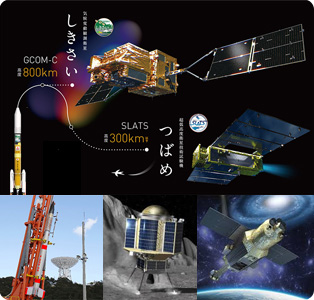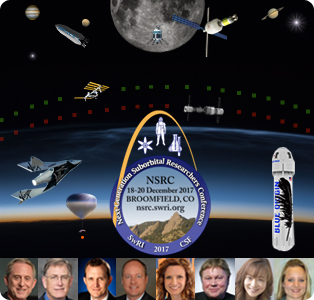Japan Prepares 2 Upcoming Launches in Advance of Lunar and Galactic Missions
|
MONDAY Ongoing…
|

![]() = All times
= All times
for terrestrial events in local time unless noted.
![]() = All times for international terrestrial events in local time unless noted.
= All times for international terrestrial events in local time unless noted.
![]() = All times for space events, and…
= All times for space events, and…
![]() = All times for international space / astro events in Hawaii Standard Time unless noted. Add 10 hours to obtain UT (‘Universal Time’).
= All times for international space / astro events in Hawaii Standard Time unless noted. Add 10 hours to obtain UT (‘Universal Time’).
Weekly Planet Watch – Evening Planets: Uranus (SE), Neptune (S); Morning Planets: Mars (ESE), Jupiter (ESE).
Next-Gen Suborbital Researchers Conference to Discuss New Technologies, Policies, Science
The 2017 Next-generation Suborbital Researchers Conference is being held December 18-20 in Broomfield, Colorado with support of SwRI, CSF, NASA, World View, Virgin Galactic, Moon Express and Blue Origin. Sponsors also include Spaceport America, Spaceport Colorado and Cecil Spaceport. The first day will have talks by (L-R) Alan Stern, Dan Dumbacher, George Whitesides, Eric Stallmer and Jane Poynter. Day two and three will have presentations by Bob Richards, Misuzu Onuki, Jane Kinney, Steve Jurczyk and Grant Anderson. There are tours planned for University of Colorado Hypervelocity Dust Impact Lab and Ball Aerospace. Blue Origin could be the first company to start regular suborbital tourism flights on New Shepard in 2018. It also is working toward orbital flights of New Glenn ~2020 and Lunar missions with the proposed New Armstrong. Hoping to revive its accomplishment of commercial human spaceflight in 2004, Virgin Galactic is making progress on SpaceShip Two VSS Unity flight testing. Sierra Nevada Dream Chaser (cargo) ship is passing glide / other tests for ISS transport, with the crewed Dream Chaser system to be developed after. Some companies are headed to the edge of Space including World View Enterprises and Zero2infinity, while Moon Express, Bigelow Aerospace, Astrobotic and SpaceX are working to transport / catalyze human expansion to the Moon, Mars and Deeper Space. (Image Credit: NGSRC, CSF, SwRI, NASA, VG, Blue Origin, Bigelow, World View Enterprises, Joel Kowsky) |
Continued from…
TUESDAY
WEDNESDAY
THURSDAY
|
![]() Dec 21 — Apollo Asteroid 2017 RP2: Near-Earth Flyby (0.058 AU).
Dec 21 — Apollo Asteroid 2017 RP2: Near-Earth Flyby (0.058 AU).
![]() Dec 21 — Amor Asteroid 2017 XN2: Near-Earth Flyby (0.086 AU).
Dec 21 — Amor Asteroid 2017 XN2: Near-Earth Flyby (0.086 AU).
FRIDAY
![]() Dec 22 — New Horizons, KBO 2014 MU69 Trajectory: Spacecraft to go into hibernation today until 4 Jun 2018 at which point it will awaken to prepare for KBO approach and flyby KBO 1 Jan 2019.
Dec 22 — New Horizons, KBO 2014 MU69 Trajectory: Spacecraft to go into hibernation today until 4 Jun 2018 at which point it will awaken to prepare for KBO approach and flyby KBO 1 Jan 2019.
![]() Dec 22 — SpaceX, Launch Falcon 9 / Iridium Next 31-40, Vandenberg AFB CA: SpaceX Falcon 9 rocket set to launch 10 satellites for Iridium next mobile communications fleet, using previously-flown first stage booster, and returning first stage to drone ship in Pacific Ocean.
Dec 22 — SpaceX, Launch Falcon 9 / Iridium Next 31-40, Vandenberg AFB CA: SpaceX Falcon 9 rocket set to launch 10 satellites for Iridium next mobile communications fleet, using previously-flown first stage booster, and returning first stage to drone ship in Pacific Ocean.
![]() Dec 22 — Space Center Houston, Houston TX: Lunch with an Astronaut, Tom Jones, adult US$69.95.
Dec 22 — Space Center Houston, Houston TX: Lunch with an Astronaut, Tom Jones, adult US$69.95.
![]() Dec 22 — The Space Show, Online / Tiburon CA: Dr. David Livingston talks with Jim Keravala, CEO of OffWorld.
Dec 22 — The Space Show, Online / Tiburon CA: Dr. David Livingston talks with Jim Keravala, CEO of OffWorld.
![]() Dec 22 — Ursid Meteor Shower Peak: Appearing to radiate from β star of Ursa Minor, Ursids are associated with comet 8P/Tuttle, they offer medium speed (33 km/sec), mostly faint with a few fireballs, 9-10 per hour, visible in northern Hemisphere, 05:00.
Dec 22 — Ursid Meteor Shower Peak: Appearing to radiate from β star of Ursa Minor, Ursids are associated with comet 8P/Tuttle, they offer medium speed (33 km/sec), mostly faint with a few fireballs, 9-10 per hour, visible in northern Hemisphere, 05:00.
![]() Dec 22 — Apollo Asteroid 2015 YQ1: Near-Earth Flyby (0.044 AU).
Dec 22 — Apollo Asteroid 2015 YQ1: Near-Earth Flyby (0.044 AU).
![]() Dec 22 — Apollo Asteroid 2017 TS3: Near-Earth Flyby (0.047 AU).
Dec 22 — Apollo Asteroid 2017 TS3: Near-Earth Flyby (0.047 AU).
![]() Dec 22 — Apollo Asteroid 2017 XX2 : Near-Earth Flyby (0.071 AU).
Dec 22 — Apollo Asteroid 2017 XX2 : Near-Earth Flyby (0.071 AU).
![]() Dec 22 — Apollo Asteroid 2007 KE: Near-Earth Flyby (0.072 AU).
Dec 22 — Apollo Asteroid 2007 KE: Near-Earth Flyby (0.072 AU).
![]() Dec 22 — Apollo Asteroid 2015 HU9: Near-Earth Flyby (0.098 AU).
Dec 22 — Apollo Asteroid 2015 HU9: Near-Earth Flyby (0.098 AU).
SATURDAY
![]() Dec 23 — JAXA, Launch H-2A / GCOM-C & SLATS, Tanegashima Space Center, Japan: Japan H-2A rocket, designated H-2A F37, to launch Global Change Observation Mission-Climate (GCOM-C) and Super Low Altitude Test Satellite (SLATS) for JAXA; live stream video available.
Dec 23 — JAXA, Launch H-2A / GCOM-C & SLATS, Tanegashima Space Center, Japan: Japan H-2A rocket, designated H-2A F37, to launch Global Change Observation Mission-Climate (GCOM-C) and Super Low Altitude Test Satellite (SLATS) for JAXA; live stream video available.
![]() Dec 23 — Mauna Kea Astronomy Outreach Committee, Mauna Kea HI, 2,800-meter level: Malalo o ka Po Lani; presentation covering cultural components that surround Mauna O Wakea, 18:00 – followed by stargazing program, at Mauna Kea Visitor Information Center.
Dec 23 — Mauna Kea Astronomy Outreach Committee, Mauna Kea HI, 2,800-meter level: Malalo o ka Po Lani; presentation covering cultural components that surround Mauna O Wakea, 18:00 – followed by stargazing program, at Mauna Kea Visitor Information Center.
![]() Dec 23 — Space Center Houston, Houston TX: Lunch with an Astronaut, Clay Anderson, adult US$69.95.
Dec 23 — Space Center Houston, Houston TX: Lunch with an Astronaut, Clay Anderson, adult US$69.95.
![]() Dec 23 — Mercury: 8.1° NNE of Antares, 15:00.
Dec 23 — Mercury: 8.1° NNE of Antares, 15:00.
SUNDAY
![]() NET Dec 24 — Roscosmos State Corporation, Launch Soyuz / Kanopus-V 3 and 4, Baikonur Cosmodrome, Kazakhstan: Russia Soyuz to launch Kanopus-V 3 and 4 Earth observation satellites to assist Russia government in disaster response, mapping and forest fire detection.
NET Dec 24 — Roscosmos State Corporation, Launch Soyuz / Kanopus-V 3 and 4, Baikonur Cosmodrome, Kazakhstan: Russia Soyuz to launch Kanopus-V 3 and 4 Earth observation satellites to assist Russia government in disaster response, mapping and forest fire detection.
![]() Dec 24 — Iridium 94, LEO: Iridium 94 satellite flare to occur over of Hawai`i Island at 06:05:37 HST, magnitude of -1, 60° altitude, distance to satellite will be about 886 km.
Dec 24 — Iridium 94, LEO: Iridium 94 satellite flare to occur over of Hawai`i Island at 06:05:37 HST, magnitude of -1, 60° altitude, distance to satellite will be about 886 km.
![]() Dec 24 — Moon: 1.4° SSE of Neptune, 04:00.
Dec 24 — Moon: 1.4° SSE of Neptune, 04:00.
![]() Dec 24 — Aten Asteroid 2017 WZ14: Near-Earth Flyby (0.019 AU).
Dec 24 — Aten Asteroid 2017 WZ14: Near-Earth Flyby (0.019 AU).
![]() Dec 24 — Apollo Asteroid 2017 WD15: Near-Earth Flyby (0.069 AU).
Dec 24 — Apollo Asteroid 2017 WD15: Near-Earth Flyby (0.069 AU).

